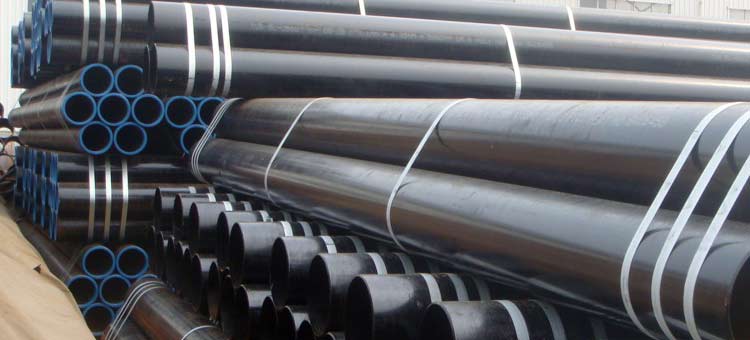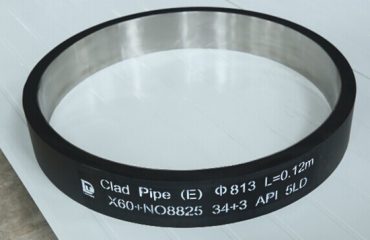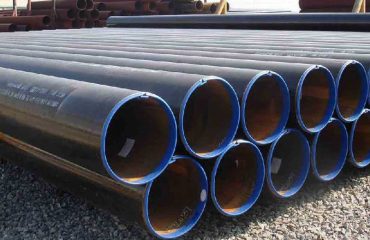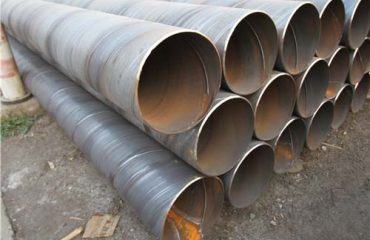
ASTM A672 Elektrofüzyon Kaynaklı (EFW) Çelik Boru
giriiş
ASTM A672, elektrik füzyon kaynaklı kaynakları kapsayan bir spesifikasyondur (EFW) Orta sıcaklıklarda yüksek basınçlı servis için tasarlanmış çelik borular. Bu borular elektrik üretimi gibi endüstrilerde yaygın olarak kullanılmaktadır., petrokimya, yağ ve gaz, ve su iletimi. Şartname imalat için yönergeler sağlar, test, Yüksek basınçlı uygulamalar için gerekli mekanik özellikleri ve performans gereksinimlerini karşıladıklarından emin olmak amacıyla çelik boruların muayenesi ve muayenesi.
EFW işlemi, çelik plakaları birbirine kaynaştırmak için elektrik arkı kullanan bir kaynak yöntemidir., uzunlamasına bir dikiş oluşturmak. Bu süreç son derece verimlidir ve mükemmel yapısal bütünlüğe ve mekanik dayanıklılığa sahip borular üretir.. ASTM A672 borular, kullanılan çeliğin türüne ve gerekli mekanik özelliklere bağlı olarak çeşitli kalitelerde mevcuttur..
Bu makale üretim sürecini inceleyecek, Mekanik Özellikler, ASTM A672 EFW çelik boruların ve uygulamaları, ve bunların sağlanması için kullanılan test yöntemleri kalite ve performans.
İçindekiler
- ASTM A672 EFW Çelik Boru Nedir??
- Manufacturing Process of ASTM A672 EFW Steel Pipe
- elektrikli füzyon kaynağı (EFW) İşlem
- ısı tedavisi
- Grades and Classes of ASTM A672 Steel Pipe
- Mechanical Properties of ASTM A672 EFW Steel Pipe
- Testing and Inspection Requirements
- basma testi (NDT)
- Hidrostatik Test
- Applications of ASTM A672 EFW Steel Pipe
- Sıkça Sorulan Sorular (SSS)
- Çözüm
ASTM A672 EFW Çelik Boru Nedir?? {#what-is-astm-a672-efw-steel-pipe}
ASTM A672 is a standard specification for electric-fusion-welded (EFW) Orta sıcaklıklarda yüksek basınçlı servis için tasarlanmış çelik borular. These pipes are fabricated from pressure vessel kalite steel plates that are fusion welded using an electric arc. Şartname, uzunlamasına dikişli boruları kapsar ve yüksek mukavemet ve dayanıklılığın gerekli olduğu uygulamalarda kullanılmak üzere tasarlanmıştır..
ASTM A672 EFW Çelik Borunun Temel Özellikleri:
-
Elektrik Füzyon Kaynaklı (EFW): Borular EFW prosesi kullanılarak üretilmektedir., çelik plakaların bir elektrik arkı kullanılarak birbirine kaynaştırılmasını içeren. Bu işlem, yüksek basınçlara dayanabilen güçlü bir uzunlamasına kaynak üretir.
-
Basınçlı Kap kalite Çelik: ASTM A672 boruların imalatında kullanılan çelik levhalar basınçlı kap kalitesindedir., yani yüksek iç basınçlara hatasız dayanacak şekilde tasarlandıkları anlamına gelir.
-
Yüksek Basınçlı Servis: ASTM A672 borular yüksek basınçlı uygulamalara uygundur, kazanlar gibi, Isı değiştiriciler, petrol ve gaz endüstrisinde boru hatları ve boru hatları.
-
Orta Sıcaklık Uygulamaları: Şartname, orta sıcaklıklarda kullanılmak üzere tasarlanmış boruları kapsar, tipik olarak 400°C'ye kadar (752° F).
-
Çeşitli Sınıflar: ASTM A672 borular, kullanılan çeliğin türüne ve gerekli mekanik özelliklere bağlı olarak farklı kalitelerde mevcuttur.. Kaliteler çeliğin kimyasal bileşimi ve ısıl işlemine göre belirlenir..
Manufacturing Process of ASTM A672 EFW Steel Pipe {#astm-a672-efw-çelik borunun üretim süreci}
ASTM A672 EFW çelik boruların imalatı birkaç adımdan oluşur, basınçlı kap kalitesinde çelik plakaların seçimi dahil, elektrikli füzyon kaynağı (EFW) İşlem, İstenilen mekanik özellikleri elde etmek için ısıl işlem.
elektrikli füzyon kaynağı (EFW) İşlem {#elektrik-füzyon-kaynak-efw-işlemi}
EFW işlemi, çelik plakaları uzunlamasına bir dikiş boyunca birbirine kaynaştırmak için bir elektrik arkı kullanan bir tür ark kaynağıdır.. Süreç aşağıdaki adımları içerir:
-
Plaka Hazırlama: The steel plates are first cut to the required dimensions and inspected for any surface defects or imperfections.
-
Edge Preparation: The edges of the steel plates are beveled to ensure proper fusion during the welding process. The bevel angle is carefully controlled to achieve a strong weld.
-
elektrikli füzyon kaynağı: The plates are positioned edge-to-edge, and an electric arc is used to melt the edges of the plates, creating a weld pool. As the arc moves along the seam, the molten metal solidifies, forming a continuous weld along the length of the pipe.
-
Kaynak denetimi: The weld is inspected for defects such as porosity, çatlaklar, veya eksik füzyon. Tahribatsız test (NDT) yöntemleri, such as ultrasonic testing or radiographic testing, are often used to ensure the quality of the weld.
-
Sizing and Shaping: Kaynak sonrası, boru istenilen çap ve yuvarlaklığa ulaşmak için bir dizi silindirden geçirilir. Boru ayrıca boyutsal doğruluk açısından da incelenir.
ısı tedavisi {#ısıl işlem}
EFW işleminden sonra, Borular, mekanik özelliklerini iyileştirmek ve kaynak sırasında oluşan artık gerilimleri azaltmak için ısıl işleme tabi tutulabilir.. Isıl işlemin türü çeliğin kalitesine ve uygulama gereksinimlerine bağlıdır.. Yaygın ısıl işlem süreçleri şunları içerir::
-
Normalleştirme: Boru kritik noktasının üzerindeki bir sıcaklığa kadar ısıtılır ve ardından havada soğutulur.. Bu işlem tane yapısını iyileştirir ve çeliğin tokluğunu artırır.
-
Söndürme ve Temperleme: Boru yüksek bir sıcaklığa kadar ısıtılır ve ardından hızla soğutulur. (söndürülmüş) su veya yağda. Daha sonra daha düşük bir sıcaklığa kadar tekrar ısıtılır. (temperlenmiş) to improve its ductility and toughness.
-
Stress giderici: The pipe is heated to a moderate temperature and then slowly cooled to relieve residual stresses without significantly altering the mechanical properties.
Grades and Classes of ASTM A672 Steel Pipe {#grades-and-classes-of-astm-a672-steel-pipe}
ASTM A672 steel pipes are available in various grades and classes based on the type of steel used and the required mechanical properties. Kaliteler çeliğin kimyasal bileşimine göre belirlenir., sınıflar ısıl işlem ve test gereksinimlerine dayalıdır.
Ortak Notlar:
-
B60 Sınıfı: Bu kalite minimum çekme dayanımına sahip karbon çeliğinden yapılmıştır. 415 MPA (60,000 PSI). Genellikle orta basınçlı uygulamalarda kullanılır..
-
C65 Sınıfı: Bu kalite, minimum çekme dayanımına sahip karbon-manganez çeliğinden yapılmıştır. 450 MPA (65,000 PSI). Daha yüksek basınçlı uygulamalar için uygundur.
-
C70 Sınıfı: Bu kalite, minimum çekme dayanımına sahip karbon-manganez çeliğinden yapılmıştır. 485 MPA (70,000 PSI). Mukavemet ve dayanıklılığın kritik olduğu yüksek basınçlı uygulamalarda kullanılır..
sınıflar:
- Sınıf 10: Bu sınıftaki borular herhangi bir ısıl işlem görmeden kaynaklı olarak tedarik edilir..
- Sınıf 12: Bu sınıftaki borular, mekanik özelliklerini iyileştirmek ve artık gerilimleri azaltmak için kaynak sonrasında ısıl işleme tabi tutulur..
- Sınıf 22: Bu sınıftaki borular, daha yüksek mukavemet ve tokluk elde etmek için su verme ve temperlemeye tabi tutulur..
Malzeme Özellikleri {#malzeme spesifikasyonu}
ASTM A672 borular yapılır basınçlı kap kaliteli çelik levhalar kullanılarak kaynak yapılır elektrikli füzyon kaynağı (EFW) İşlem. Şartname çeşitli tiplerdeki boruları kapsamaktadır. Notlar ve sınıflar, tarafından belirlenen Kimyasal bileşimi çelik ve ısı tedavisi kaynak sonrası uygulanan.
ASTM A672 EFW Çelik Borunun Temel Özellikleri:
- Elektrik Füzyon Kaynaklı (EFW): Borular bir kullanılarak kaynaklanır elektrik arkı çelik plakaları kaynaştırmak, bir yaratmak boyuna kaynak.
- Basınçlı Kap Kalite Çelik: Kullanılan çelik levhalar basınçlı kap kalitesi, boruların dayanabilmesini sağlamak yüksek iç basınçlar.
- Yüksek Basınçlı Servis: ASTM A672 borular aşağıdakiler için tasarlanmıştır: yüksek basınçlı uygulamalar de ılımlı sıcaklıklar.
- Sınıflar ve Sınıflar: Spesifikasyon birden fazla sağlar Notlar ve sınıflar dayalı Kimyasal bileşimi ve ısı tedavisi çelik.
Kimyasal Bileşim Tablosu {#kimyasal-bileşim-tablosu}
ASTM A672 çelik boruların kimyasal bileşimi, Sınıf kullanılan çeliğin. Aşağıdaki tablo, ASTM A672 borularında kullanılan yaygın kaliteler için tipik kimyasal bileşimi özetlemektedir..
| ELEMAN | B60 Sınıfı (%) | C65 Sınıfı (%) | C70 Sınıfı (%) |
|---|---|---|---|
| Karbon (C) | 0.26 MAX | 0.24 MAX | 0.23 MAX |
| Manganez (MN) | 0.98 MAX | 1.20 MAX | 1.35 MAX |
| fosfor (P) | 0.035 MAX | 0.035 MAX | 0.035 MAX |
| Kükürt (S) | 0.035 MAX | 0.035 MAX | 0.035 MAX |
| Silikon (Si) | 0.13-0.45 | 0.13-0.45 | 0.13-0.45 |
| Krom (CR) | 0.30 MAX | 0.30 MAX | 0.30 MAX |
| Nikel (Ni) | 0.30 MAX | 0.30 MAX | 0.30 MAX |
| Molibden (Mo) | 0.12 MAX | 0.12 MAX | 0.12 MAX |
| Bakır (Cu) | 0.40 MAX | 0.40 MAX | 0.40 MAX |
| Vanadyum (V) | 0.08 MAX | 0.08 MAX | 0.08 MAX |
notlar:
- Karbon İçeriği belirlenmesinde önemli bir faktördür. Gücü ve Sertlik çelik. Düşük karbon içeriği iyileşiyor kaynaklanabilirlik ve süneklik.
- Manganez iyileştirir Çekme dayanımı ve sertleşebilirlik çelik.
- fosfor ve Kükürt önlemek için düşük seviyelerde tutulur. kırılganlık ve dayanıklılığı artırmak.
- Silikon olarak hareket eder oksit giderici çelik üretim süreci sırasında ve geliştirir Gücü.
Mekanik Özellikler Tablosu {#mekanik-özellikler-tablosu}
ASTM A672 çelik boruların mekanik özellikleri aşağıdakiler tarafından belirlenir: Sınıf ve Sınıf borunun, aynı zamanda ısı tedavisi kaynak sonrası uygulanan. Aşağıdaki tablo, yaygın olarak kullanılan ASTM A672 boru kaliteleri için tipik mekanik özellikleri göstermektedir..
| Mülk | B60 Sınıfı | C65 Sınıfı | C70 Sınıfı |
|---|---|---|---|
| Çekme dayanımı (MPA) | 415 min (60,000 PSI) | 450 min (65,000 PSI) | 485 min (70,000 PSI) |
| Verim gücü (MPA) | 240 min (35,000 PSI) | 275 min (40,000 PSI) | 275 min (40,000 PSI) |
| Kopma uzaması (%) | 22 min | 22 min | 22 min |
| Darbe Dayanıklılığı (J) | Sınıfa göre değişir | Sınıfa göre değişir | Sınıfa göre değişir |
notlar:
- Çekme dayanımı malzemenin kırılmadan önce dayanabileceği maksimum gerilimdir.
- Verim gücü malzemenin plastik olarak deforme olmaya başladığı strestir.
- Kopma uzaması malzemenin sünekliğinin bir ölçüsüdür, kırılmadan önce ne kadar uzayabileceğini gösteren.
- Darbe Dayanıklılığı tipik olarak kullanılarak ölçülür Charpy V çentik testleri, özellikle uygulamalar için düşük sıcaklıktaki ortamlar.
Testing and Inspection Requirements {#test-ve-muayene-gereksinimleri}
ASTM A672 EFW çelik boruların kalitesini ve performansını sağlamak, Üretim sürecinde çeşitli test ve muayene yöntemleri kullanılır. Bu testler, borunun mekanik özelliklerini veya yapısal bütünlüğünü tehlikeye atabilecek malzeme veya kaynaktaki herhangi bir kusur veya tutarsızlığın belirlenmesine yardımcı olur..
basma testi (NDT) {#tahribatsız muayene-ndt}
basma testi (NDT) Malzemeye zarar vermeden kaynak dikişini ve boru gövdesini kusurlara karşı incelemek için yöntemler kullanılır. Yaygın NDT yöntemleri şunları içerir::
-
Ultrasonik muayene (ÇIKIŞ): Çatlaklar gibi iç kusurları tespit etmek için ultrasonik dalgalar kullanılır, boşluklar, veya kaynak veya boru gövdesinde eksik erime.
-
Radyografik Test (RT): Kaynağın görüntüsünü oluşturmak için X ışınları veya gama ışınları kullanılır, allowing inspectors to identify internal defects such as porosity, cüruf kalıntıları, or cracks.
-
Manyetik Parçacık Testi (MT): This method is used to detect surface defects in ferromagnetic materials. A magnetic field is applied to the pipe, and iron particles are used to reveal any cracks or discontinuities on the surface.
-
girinim testi (PT): A dye is applied to the surface of the pipe, and any cracks or defects will absorb the dye, making them visible under ultraviolet light.
Hidrostatik Test {#hydrostatic-testing}
Hydrostatic testing is a critical test used to ensure that the pipe can withstand the internal pressure it will be subjected to in service. During this test, the pipe is filled with water and pressurized to a level higher than its operating pressure. The pipe is then inspected for any leaks or deformations that may indicate a weakness in the material or weld.
- test basıncı: Test basıncı tipik olarak 1.5 borunun tasarım basıncının çarpımı.
- Süre: Boru belirli bir süre boyunca test basıncında tutulur (genellikle 5 Hedef 15 dakika) Basıncı hatasız olarak koruyabildiğinden emin olmak için.
Applications of ASTM A672 EFW Steel Pipe {#astm-a672-efw-çelik-boru uygulamaları}
ASTM A672 EFW çelik borular, yüksek basınçlı servis ve yapısal bütünlüğün kritik olduğu çok çeşitli endüstrilerde ve uygulamalarda kullanılmaktadır.. Bazı yaygın uygulamalar şunları içerir::
-
enerji üretimi: Kazanlarda ASTM A672 borular kullanılmaktadır, Isı değiştiriciler, Yüksek basınçlara ve orta sıcaklıklara dayanabilme yetenekleri nedeniyle enerji santrallerindeki buhar boru hatları.
-
Petrokimya endüstrisi: Bu borular rafinerilerde kullanılıyor, Kimyasal bitkiler, ve aşındırıcı sıvıların ve gazların yüksek basınç altında taşınmasına yönelik petrokimya tesisleri.
-
Petrol ve gaz endüstrisi: ASTM A672 borular petrol ve gaz boru hatlarında kullanılmaktadır, Açık deniz platformları, ve ham petrolün taşınması için deniz altı boru hatları, doğal gaz, ve diğer hidrokarbonlar.
-
Su İletimi: These pipes are used in water transmission systems for transporting potable water, wastewater, and industrial water under high pressure.
-
Structural Applications: ASTM A672 pipes are used in structural applications such as columns, kirişler, and supports in buildings and industrial structures where strength and durability are required.
Sıkça Sorulan Sorular (SSS) {#SSS}
1. What is the difference between EFW and ERW pipes?
EFW (Elektrik Füzyon Kaynaklı) Borular, çelik plakaları birbirine kaynaştırmak için elektrik arkı kullanılarak kaynak yapılır, ERW iken (Elektrik direnç kaynaklı) Borular, çeliğin kenarlarını ısıtmak ve bunları birbirine kaynaştırmak için elektrik direnci kullanılarak kaynak yapılır. EFW boruları genellikle yüksek basınçlı uygulamalar için kullanılır, ERW boruları düşük ila orta basınçlı uygulamalar için kullanılırken.
2. ASTM A672 boruların ortak kaliteleri nelerdir??
ASTM A672 borularının yaygın sınıfları arasında Sınıf B60 bulunur, C65 Sınıfı, ve C70 Sınıfı, Çeliğin kimyasal bileşimine ve mekanik özelliklerine dayanan.
3. ASTM A672 boruları için maksimum çalışma sıcaklığı nedir??
ASTM A672 boruları orta sıcaklıklarda kullanılmak üzere tasarlanmıştır, tipik olarak 400°C'ye kadar (752° F), borunun derecesine ve sınıfına bağlı olarak.
4. ASTM A672 boruların kalitesi nasıl sağlanır??
ASTM A672 boruların kalitesi tahribatsız testlerle sağlanır (NDT) ultrasonik test gibi yöntemler, Radyografik Test, and magnetic particle testing, as well as hydrostatic testing to verify the pipe’s ability to withstand internal pressure.
5. What industries use ASTM A672 EFW steel pipes?
ASTM A672 EFW steel pipes are used in industries such as power generation, petrokimya, yağ ve gaz, and water transmission due to their ability to withstand high pressures and moderate temperatures.
Çözüm {#Çözüm}
ASTM A672 EFW steel pipes are designed for high-pressure service at moderate temperatures, making them ideal for use in industries such as power generation, petrokimya, yağ ve gaz, ve su iletimi. elektrikli füzyon kaynağı (EFW) process ensures a strong longitudinal weld that can withstand high internal pressures, while the use of pressure vessel quality steel ensures the pipes have the necessary mechanical properties for demanding applications.
The testing and inspection requirements outlined in ASTM A672, including nondestructive testing and hydrostatic testing, help to ensure the quality and performance of the pipes, making them a reliable choice for high-pressure and structural applications.




Olmalısın giriş Yorum yazmak için.